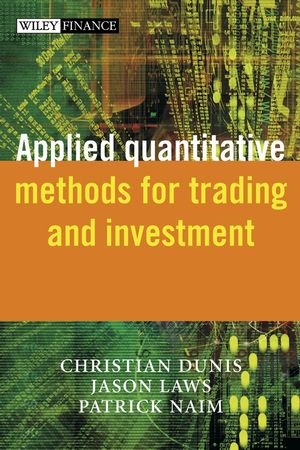Applied Quantitative Methods for Trading and InvestmentISBN: 978-0-470-84885-2
Hardcover
426 pages
October 2003
 This is a Print-on-Demand title. It will be printed specifically to fill your order. Please allow an additional 10-15 days delivery time. The book is not returnable.
|
||||||
Preface.
1 Applications of Advanced Regression Analysis for Trading and Investment (Christian L. Dunis and Mark Williams).
Abstract.
1.1 Introduction.
1.2 Literature review.
1.3 The exchange rate and related financial data.
1.4 Benchmark models: theory and methodology.
1.5 Neural network models: theory and methodology.
1.6 Forecasting accuracy and trading simulation.
1.7 Concluding remarks.
2 Using Cointegration to Hedge and Trade International Equities (A. Neil Burgess).
Abstract.
2.1 Introduction.
2.2 Time series modelling and cointegration.
2.3 Implicit hedging of unknown common risk factors.
2.4 Relative value and statistical arbitrage.
2.5 Illustration of cointegration in a controlled simulation.
2.6 Application to international equities.
2.7 Discussion and conclusions.
3 Modelling the Term Structure of Interest Rates: An Application of Gaussian Affine Models to the German Yield Curve (Nuno Cassola and Jorge Barros Luis).
Abstract.
3.1 Introduction.
3.2 Background issues on asset pricing.
3.3 Duffie–Kan affine models of the term structure.
3.4 A forward rate test of the expectations theory.
3.5 Identification.
3.6 Econometric methodology and applications.
3.7 Estimation results.
3.8 Conclusions.
4 Forecasting and Trading Currency Volatility: An Application of Recurrent Neural Regression and Model Combination (Christian L. Dunis and Xuehuan Huang).
Abstract.
4.1 Introduction.
4.2 The exchange rate and volatility data.
4.3 The GARCH (1,1) benchmark volatility forecasts.
4.4 The neural network volatility forecasts.
4.5 Model combinations and forecasting accuracy.
4.6 Foreign exchange volatility trading models.
4.7 Concluding remarks and further work.
5 Implementing Neural Networks, Classification Trees, and Rule Induction Classification Techniques: An Application to Credit Risk (George T. Albanis).
Abstract.
5.1 Introduction.
5.2 Data description.
5.3 Neural networks for classification in Excel.
5.4 Classification tree in Excel.
5.5 See5 classifier.
5.6 Conclusions.
6 Switching Regime Volatility: An Empirical Evaluation (Bruno B. Roche and Michael Rockinger).
Abstract.
6.1 Introduction.
6.2 The model.
6.3 Maximum likelihood estimation.
6.4 An application to foreign exchange rates.
6.5 Conclusion.
7 Quantitative Equity Investment Management with Time-Varying Factor Sensitivities (Yves Bentz).
Abstract.
7.1 Introduction.
7.2 Factor sensitivities defined.
7.3 OLS to estimate factor sensitivities: a simple, popular but inaccurate method.
7.4 WLS to estimate factor sensitivities: a better but still sub-optimal method.
7.5 The stochastic parameter regression model and the Kalman filter: the best way to estimate factor sensitivities.
7.6 Conclusion.
8 Stochastic Volatility Models: A Survey with Applications to Option Pricing and Value at Risk (Monica Billio and Domenico Sartore).
Abstract.
8.1 Introduction.
8.2 Models of changing volatility.
8.3 Stochastic volatility models.
8.4 Estimation.
8.5 Extensions of SV models.
8.6 Multivariate models.
8.7 Empirical applications.
8.8 Concluding remarks.
9 Portfolio Analysis Using Excel (Jason Laws).
Abstract.
9.1 Introduction.
9.2 The simple Markovitz model.
9.3 The matrix approach to portfolio risk.
9.4 Matrix algebra in Excel when the number of assets increases.
9.5 Alternative optimisation targets.
9.6 Conclusion.
10 Applied Volatility and Correlation Modelling Using Excel (Frederick Bourgoin).
Abstract.
10.1 Introduction.
10.2 The Basics.
10.3 Univariate models.
10.4 Multivariate models.
10.5 Conclusion.
11 Optimal Allocation of Trend-Following Rules: An Application Case of Theoretical Results (Pierre Lequeux).
Abstract.
11.1 Introduction.
11.2 Data.
11.3 Moving averages and their statistical properties.
11.4 Trading rule equivalence.
11.5 Expected transactions cost under assumption of random walk.
11.6 Theoretical correlation of linear forecasters.
11.7 Expected volatility of MA.
11.8 Expected return of linear forecasters.
11.9 An applied example.
11.10 Final remarks.
References.
12 Portfolio Management and Information from Over-the-Counter Currency Options (Jorge Barros Luis).
Abstract.
12.1 Introduction.
12.2 The valuation of currency options spreads.
12.3 RND estimation using option spreads.
12.4 Measures of correlation and option prices.
12.5 Indicators of credibility of an exchange rate band.
12.6 Empirical applications.
12.7 Conclusions.
13 Filling Analysis for Missing Data: An Application to Weather Risk Management (Christian L. Dunis and Vassilios Karalis).
Abstract.
13.1 Introduction.
13.2 Weather data and weather derivatives.
13.3 Alternative filling methods for missing data.
13.4 Empirical results.
13.5 Concluding remarks.
Index.



